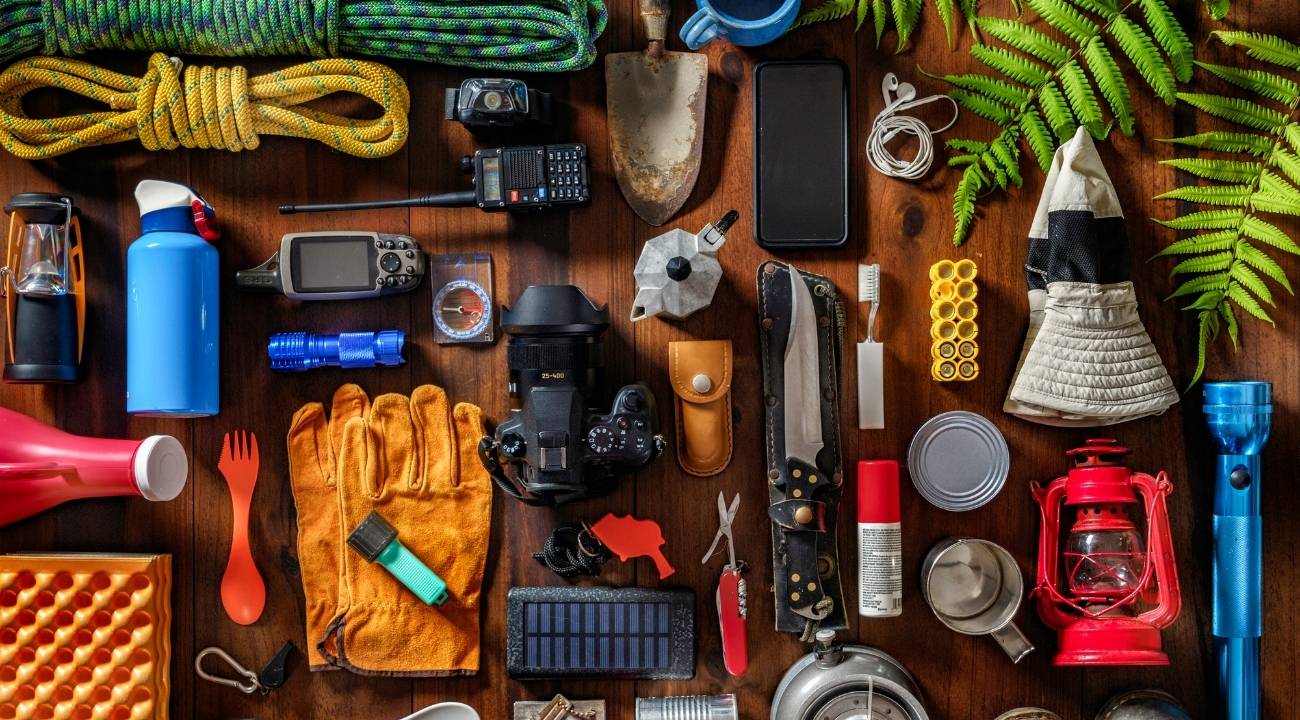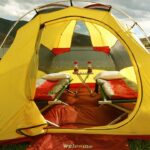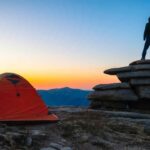Hiking through deep snow can be incredibly exciting, immersing you in a peaceful winter wonderland. However, it’s important to be aware of the potential dangers that come with it.
One such danger is falling through deep snow, which can turn your enjoyable hike into a difficult and even life-threatening situation. Depending on the location, terrain, and weather, it can take hours or days for rescuers to reach you.
In the meantime, you are exposed to freezing temperatures, low oxygen levels, and potential injuries. Hypothermia and frostbite are common causes of death or disability for people who fall into deep snow.
In this easy-to-understand guide, we will provide you with essential knowledge and practical tips on what to do if you find yourself falling through deep snow while hiking.
If you suddenly find yourself sinking into deep snow, staying calm and acting quickly is crucial. Panicking can cloud your judgment and make it harder to make good decisions.
By understanding the right steps to take, you can reduce the risks and increase your chances of staying safe. So, let’s dive into the details and discover the best practices that will ensure your safety and allow you to enjoy stunning winter landscapes without worries.
What To Do If You Fall Through Deep Snow Hiking
Walking or hiking through thick snow can be really exciting, but it can also be dangerous. One of the things that can be dangerous is when you sink really deep into the snow.
It can make you feel lost and it might be risky. But if you know what to do and you are ready, you can figure out how to handle this problem and make sure you stay safe.
Stay Afloat and Conserve Energy
Falling into deep snow can be really hard on your body, and if you try to move too much, you will get tired quickly. After figuring out what’s going on, it’s crucial to keep yourself above the snow.
Open your arms really wide, like you’re giving a big hug, and move your legs gently to stay on top of the water. Imagine you are lying on your back in a swimming pool and pretending to move like you are floating in the water.
This will help you not go deeper under the water and save your energy.
Create an Air Pocket
If you ever get stuck in a lot of snow, it’s really important to make a space where you can breathe in the snow. When you are going underwater, put your hands in front of your face like a cup to make a little hole where you can breathe.
Try to keep your head near the top of the water and take big, slow breaths. This will make sure you have enough air while you figure out how to get away.
Call for Help
If you have a way that can give you the advantage to talk to people, like a cell phone, use it (call 911) to ask for help right away. Tell someone you trust, like a police officer or a grown-up you know, about what’s happening to you and tell them where you are.
When you are walking with a bunch of people in the mountains or forests, if you need to talk to them or get their attention, you can yell really loud or blow a whistle to make sure they hear you.
It’s really important to let someone know if you’re in trouble so they can help you or call for help if necessary.
Assess Your Surroundings
While you’re waiting for someone to come help you, look around and see what you can do to self-help yourself from where you are. This will help the person who comes to rescue you find you more easily.
Try to find things around you that stand out or are easy to recognize. These things can help the people trying to find you know exactly where you are.
Try to remember which way you were walking, any other paths or special places you passed by, and any unique things in nature that you saw. This information will be important when telling the people who are coming to help where you are.
Slowly Extract Yourself
If you can move your body and the snow is not too hard, try to get yourself out of the deep snow slowly. Lie on your back and move your arms and legs like you’re swimming to go up to the top.
When you walk on something soft like sand or mud, make sure to put the same amount of pressure on each foot so that you don’t sink in too much. Once you climb up to the top, move away from where you fell and go to a safer place to stand.
When you can rescue yourself from this danger either by yourself or with someone’s help, then do the following.
Seek Shelter and Warmth
After getting out of the heavy snow, it’s really important to find a safe place to stay and get warm. If you fall into deep snow, you can get wet and cold, which can make you very sick.
Find something in nature, like a tree or a big pile of rocks, that can keep you safe from wind, rain, and sun. Keep yourself warm and cozy by putting something like your hiking backpack or anything else you have under you when you’re sitting or lying down on cold ground.
If you can, put on clothes that are not wet and keep moving to stay warm.
Stay Hydrated and Nourished
While you’re waiting for help or trying to find your way home, it’s really important to drink enough water and eat enough food to keep your body healthy.
Falling into deep snow and dealing with what happens afterward can make your body very tired, so it’s crucial to make sure you have enough energy to keep going.
If you have a little bit of food and water, it’s best to eat and drink just a little bit at a time. Don’t eat snow because it will make you colder inside.
You can either put snow in a container and let it turn into water, or use a special machine to clean the snow and make it safe to drink.
Learn from the Experience
Once you are safe and have overcome the ordeal of falling through deep snow while hiking, take the time to reflect and learn from the experience. Evaluate what went wrong and identify the factors that led to your fall.
This self-reflection will help you avoid similar situations in the future and improve your hiking skills. Consider taking a winter survival course or consulting with experienced hikers to gain additional knowledge and expertise.
Precautions Before Going Deep Snow Hiking
Winter hiking offers several advantages worth considering.
- Firstly, the trail tends to be less crowded, providing a tranquil atmosphere for a deeper connection with nature.
- Secondly, hiking in snowy conditions introduces distinctive obstacles that experienced hikers find exhilarating.
Here are some tips to help you prepare for your next deep snow hiking:
Check out the hiking trails
Due to the hazardous weather, snow, and ice, much more investigation is required during the winter. You should specifically verify the weather forecast, recent snowfall in the area, and the regional landslide forecast.
If any of these sources indicate that your hike would be harmful or risky, you should postpone it until conditions and the forecast improved.
Bring Necessary Equipment
The most obvious risk of trekking in the snow is slipping on icy snow and ice on the trail. The secret is to use proper winter hiking gear to increase your traction on the trail surface.
Microspikes are chains on the bottom of your shoes with little steel teeth that grab the ice and snow. Trekking poles are similar to large ski poles in that they provide four points of contact while traversing snow and ice.
When trekking in the cold, I recommend utilizing both. You don’t need to buy a costly pair to get started; something simple would suffice.
If it has just snowed or you are visiting an unpopular trail, you should bring a pair of snowshoes with you. Breaking trails in the snow is exhausting and can quickly get you wet and freezing.
Unless you plan to just hike on popular trails and wait for a few days after significant storms, a pair of snowshoes, especially with traction for slopes, is an essential piece of winter hiking equipment.
Even so, a pair of snowshoes is certainly worth the price in windblown places where snow can accumulate quickly.

Use an insulated water bottle
In the summer, I love using a Camelbak-style hose to stay hydrated, but during the cold winter months, this system fails. Water starts to freeze and clogs the hose and tube. Instead, use an insulated water container to keep your water liquid and drinkable.
I also suggest taking a thermos filled with coffee or hot chocolate. It’ll come in useful if you get stuck on the summit! Bring a small backpacking move if you think you’ll need additional water when hiking in the snow. It will be required to melt snow and ice!
Avoid afternoon slush
The sunlight shines brighter at higher elevations in the mountains. Even in the dead of winter, damp, unsupportive, and potentially mushy snow can accumulate by the afternoon.
To avoid this problem, begin your hiking early in the winter and spring months. As an added bonus, if you make slower progress than predicted, you will have more time to return before nightfall.
If you anticipate a late return, you should bring a pair of snowshoes with you. Even though they aren’t necessary for the morning when the snow is frozen and hard-packed, they may come in handy later in the day when they become unsupportive and you begin to posthole.
Hand and foot warmers
While your core temperature may be warm, your fingers and toes are especially vulnerable to frostbite. Even if you’re wearing gloves and warm socks, checking on your extremities while hiking in the snow is a smart idea.
I recommend having hand and foot warmers with you. They provide extra warmth, which is a valuable indulgence on a cold winter night in the highlands.
Use gaiters
Nothing is worse in the cold than wet socks and boots. The simplest way to accomplish this is to allow snow inside your shoes by accident while hiking.
A decent pair of waterproof gaiters will keep your socks toasty and dry by covering the gap between your boots and the end of your jeans. If you’re going to be walking through deep snow, purchase a knee-length pair.
Otherwise, something just above your ankle will suffice for snow hiking.
Learn to navigate without a clear trail
If you expect to be able to follow a clear track when trekking in the snow, think again. While popular trails may have a packed down path to follow, it is much more difficult to read than a trail and may lead you astray.
Bring a GPS device or an app on your phone, as well as a hiking map of the area, to assist you in navigating even if you discover no trail to follow or it disappears along the way.
In the winter, I prefer to hike familiar paths to make navigation easy.
Have someone dependable
Even with the best preparations and equipment, it is possible to fall into problems in the mountains while trekking in the snow.
This is why you should always leave your plans and itinerary with someone trustworthy at home so that they may seek assistance if you don’t return when you said you would.
The more information you can leave, such as your vehicle’s make and model, what you’re wearing, and what supplies you have with you, the better.
It is especially vital when hiking in the snow, where you can quickly become buried in powder, requiring rescuers to know what color clothing you are wearing.
Bring the essentials
The ten essentials are a set of important gear and equipment that are essential for your safety in the mountains, especially if something goes wrong.
Whenever you go hiking in the snow, it’s crucial to have these ten hiking essentials with you. They include:
- Navigation Gear: This includes a map, compass, and GPS device to help you find your way and avoid getting lost in the snowy terrain.
- Headlamp and Extra Batteries: It’s important to have a headlamp to light your way, especially during the shorter daylight hours of winter. Don’t forget to bring extra batteries in case they run out.
- Extra Food: When hiking in the snow, your body requires more energy to keep warm. Pack extra food to provide the necessary fuel and keep your energy levels up.
- Extra Layers: Winter weather can be unpredictable, and temperatures can drop rapidly. Carry extra layers of clothing to stay warm and protect yourself from the cold.
- Firestarter and Ignition Source: In case of an emergency or to keep warm, it’s crucial to have a firestarter, such as waterproof matches or a lighter, along with a reliable ignition source.
- Water and Filter: Staying hydrated is essential in any season, including winter. Carry enough water with you and a water purifier or filter to ensure a safe drinking supply if needed.
- Knife or Multi-tool: A versatile tool like a knife or multi-tool can be handy for various purposes, such as cutting rope, repairing gear, or handling emergencies.
- Sun Protection: Snow can reflect sunlight and intensify its effects. Protect your skin and eyes by wearing sunscreen, sunglasses, and a hat to shield yourself from the sun’s rays.
- First Aid Kit: Accidents can happen even during a peaceful hike. Carry a well-stocked first aid kit with essentials like bandages, pain relievers, and any necessary medications.
- Emergency Shelter: If you become stranded or need to take shelter from extreme weather conditions, having an emergency shelter like a lightweight tent or bivvy bag can provide crucial protection.
Remember, these ten essentials are vital for your safety and well-being when hiking in snowy conditions. Make sure to pack them before heading out on your winter adventure.
Wrapping Up
Falling in deep snow while hiking can be a terrifying experience, but with the appropriate knowledge and preparation, you can overcome this obstacle.
Remember to analyze the situation immediately, stay afloat, create an air pocket, and, if feasible, phone for assistance. Evaluate your surroundings, progressively withdraw if possible, seek shelter and warmth, and emphasize remaining hydrated and nourished.
Once you’re secure, make use of the opportunity to learn from your experience and improve your hiking abilities. You may protect your safety and enjoy the delights of deep snow hiking by following these suggestions.
Frequently Asked Questions (FAQ)
Q: How can I prevent falling through deep snow while hiking?
A: To prevent falling through deep snow, it’s important to stay on marked trails, follow safety guidelines, and use appropriate equipment such as snowshoes or crampons. Check weather conditions before your hike and avoid venturing into areas with high avalanche risks.
Q: Should I hike alone in deep snow?
A: It’s generally recommended to hike with a partner or a group when tackling challenging terrains such as deep snow. Having others with you provides an extra layer of safety and support in case of emergencies.
Q: What should I do if I don’t have any means of communication?
A: If you find yourself without any means of communication after falling through deep snow, it’s essential to remain calm and follow the steps outlined in this article. Stay afloat, create an air pocket, assess your surroundings, and attempt to slowly extract yourself. Prioritize seeking shelter, and warmth, and staying hydrated until help arrives.

Diana Miller, is a dedicated nature enthusiast and an outdoor adventurer. She began leading groups for excursions in her teens and never stopped. Following her passion for nature, she gathers her friends for outdoor trips every now and then. And for the last 10 years, she has executed workshops on backpacking, snow kayaking and traveling that included her main motive of lightweight packing while outdoors. During leisure, she loves planning for her next adventure.









Leave a Comment